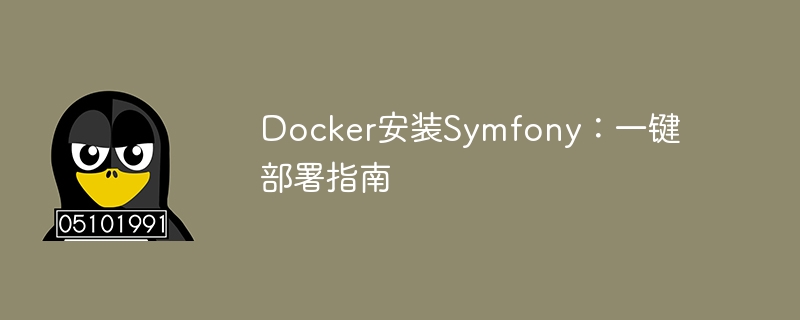

Docker Installation of Symfony: One-Click Deployment Guide
Introduction:
Symfony is a popular PHP framework that provides powerful tools and functions for convenience Developers build high-performance, scalable web applications. Docker is an open source containerization platform that can package applications and their running environments into an independent, portable container, making application deployment and management easier. This article will introduce how to use Docker to quickly and easily deploy Symfony.
Part One: Preparation
Before we start deploying Symfony, we need to ensure that Docker and Docker Compose have been installed in our development environment. You can find the corresponding installation tutorial on the Docker official website.
Part 2: Create a Symfony application
First, we need to create a Symfony application. Open a terminal and enter a directory used to store applications, and execute the following command:
$ docker run --rm -v $(pwd):/app composer create-project symfony/website-skeleton my_app
This command will create a Symfony application named my_app in the current directory.
Part 3: Configure the Docker Compose file
Create a file named docker-compose.yml in the project root directory and write the following content:
version: '3'
services:
php:
build:
context: .
dockerfile: docker/php/Dockerfile
volumes:
- .:/var/www/html
nginx:
image: nginx:latest
ports:
- 80:80
volumes:
- .:/var/www/html
- ./docker/nginx/default.conf:/etc/nginx/conf.d/default.conf
mysql:
image: mysql:latest
environment:
MYSQL_ROOT_PASSWORD: root
volumes:
- db_data:/var/lib/mysql
volumes:
db_data:This configuration file Three services are defined: php, nginx and mysql. The php service is built using a Dockerfile. We need to create a directory named docker/php in the project root directory, create a Dockerfile file in this directory, and write the following content:
FROM php:7.4-fpm-alpine RUN docker-php-ext-install pdo_mysql WORKDIR /var/www/html
This The Dockerfile defines a Docker container based on the php:7.4-fpm-alpine image, installs the pdo_mysql extension, and sets the working directory to /var/www/html.
Create a file named default.conf in the docker/nginx directory and write the following content:
server {
listen 80;
server_name localhost;
root /var/www/html/public;
location / {
try_files $uri /index.php$is_args$args;
}
location ~ ^/index.php(/|$) {
fastcgi_pass php:9000;
fastcgi_split_path_info ^(.+.php)(/.*)$;
include fastcgi_params;
fastcgi_param SCRIPT_FILENAME $document_root$fastcgi_script_name;
fastcgi_param PATH_INFO $fastcgi_path_info;
}
}This configuration file defines the Nginx virtual host and forwards the request to the PHP service .
Part 4: Start the application
Execute the following command in the project root directory to start the application:
$ docker-compose up -d
This command will start three containers: php, nginx and mysql, and Runs in the background.
Part 5: Access the application
Access http://localhost in the browser to see the welcome page of the Symfony application.
Conclusion:
By using Docker, we can deploy Symfony applications quickly and easily. With just a few simple steps, you can easily set up a Symfony development environment. Docker's containerization technology makes application deployment and management simpler and more reliable, greatly improving development efficiency and application scalability. I hope this article is helpful to everyone, and I wish you a happy Symfony development journey!
The above is the detailed content of Docker installation of Symfony: one-click deployment guide. For more information, please follow other related articles on the PHP Chinese website!
 The difference between k8s and docker
The difference between k8s and docker
 What are the methods for docker to enter the container?
What are the methods for docker to enter the container?
 What should I do if the docker container cannot access the external network?
What should I do if the docker container cannot access the external network?
 What is the use of docker image?
What is the use of docker image?
 How to use each function in js
How to use each function in js
 Introduction to the levels of Python exams
Introduction to the levels of Python exams
 Usage of between function
Usage of between function
 What should I do if English letters appear when I turn on the computer and the computer cannot be turned on?
What should I do if English letters appear when I turn on the computer and the computer cannot be turned on?




